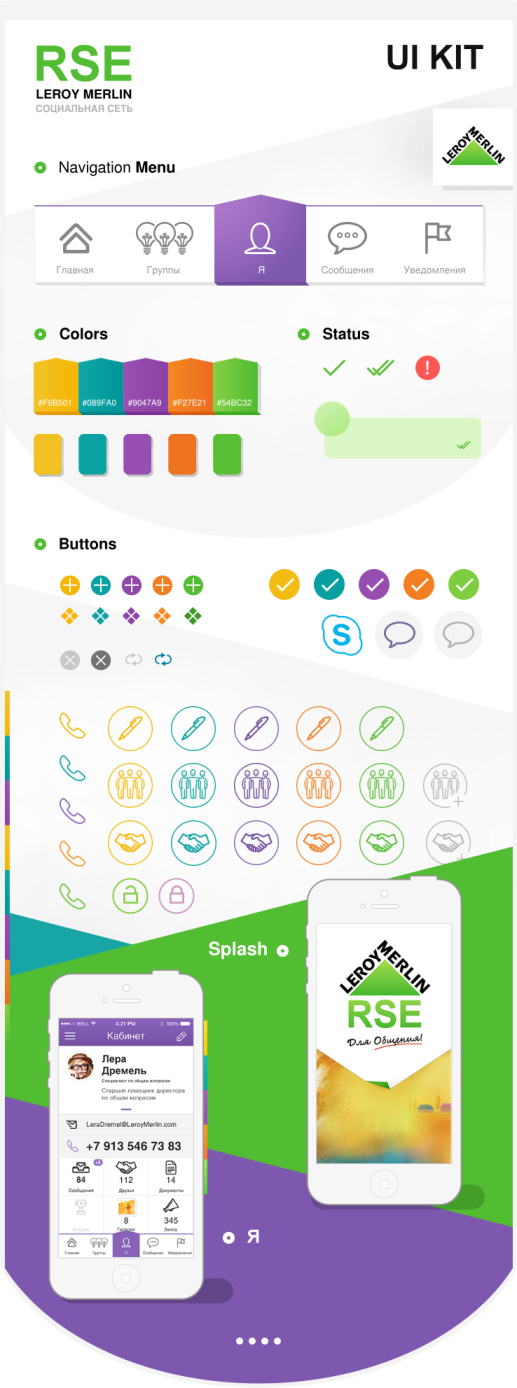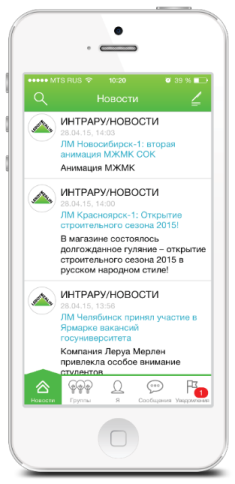Corporate social network - why and for whom?
In early 2015, we released a corporate mobile application that supports a social network for Leroy Merlin. The application was developed entirely by us, taking into account the specifics of the company and the goals of our customer.
In a large branched company, internal communications play a very important role. Our goal was to realize them not just qualitatively, but with benefits for the customer’s business. In essence, corporate communications should have become a working tool that performs certain tasks. But first things first.

Why do we need social networks? If we discard their ability to eat upworking time and a battery on a smartphone, communication remains a useful feature: photo-video content sharing, reposts and private messages, chat rooms and interest groups. Communication, in fact. Inside a geographically distributed company they are needed. They help employees who are not familiar with offline, communicate and share information, participate in common online events and events. Share and share experiences. Summarizing, we can say that they help to work more efficiently.
')
The goal of the customer was to make a mobile version of the social network, which at that time already existed in a web format on the corporate portal. 75% of the company's employees work without constant access to a desktop computer, but have the opportunity to go online from their smartphones, so a mobile solution was the only possible way out. In this case, the mobile solution had to be integrated with the portal version, which was made and served by another company.
At the first stage, we work out the requirements for the application. This is usually a rather complicated process, but in the case of a social network, it was simple and interesting - in fact, almost every person is familiar with different social networks. However, in order not to miss anything, we have formed a list of functional requirements for the application. Using the example of working with groups, it looks like this:
Groups
1 Screen with a list of my groups:
- see the list of groups
- in each cell, a brief information about the group: avatar, sign open / closed, the number of likes of the group, the number of users in the group
- the ability to put a group like
- go to the screen to search for groups
- go to the screen with invitations to join the group
- transition to the group creation screen
- go to screen with group profile
2 Screen to create a group:
- choose avatar for the group
- enter the name of the group
- enter a description of the group
- choose the type of group: open or closed
- create a group
3 Screen for searching groups:
- enter keywords into the search field and get the result - list of groups relevant to the query
- scroll down and get the next batch of found groups
- see a brief information about each group: avatar, open / closed, the number of likes of the group, the number of users in the group
- go to screen with group profile
Our company has a proven technology for creating the mobile application itself. We collect requirements, form the concept of the application and the technical task. Having received a structured list of functional requirements, we began to work out screen transitions. Here we show only a small part of working with groups:

Then we work through the User interface and screen design, focusing on the customer’s corporate style and brand book. This is one of the most important moments, as it determines the appearance of the application and causes the largest feedback from the customer. We gradually do the UI-kit and coordinate it with the customer, then develop screens with all the controls and also go through coordination with the customer. At this stage of the project there are always a lot of discussions: we offer various options, collect feedback from the client and as a result jointly choose the best versions.

Once we and the customer have a vision of how the application screens should look, you can make requirements for the server side. To work with the portal, we designed and implemented a service that provided interaction between applications and the core of the social network. During implementation, we had to interact with both the Web interface and directly with the SharePoint methods on which the web solution was implemented.

Without challenges to professionalism, experience and wit, the project is considered uninteresting and boring. This one was not boring. At the stage of implementation and testing of the application, there were some interesting tasks that we had to solve:
Different authentication schemes work on the internal and external networks of the company. Outside access is carried out according to the Basic authentication scheme, and inside - with the help of NTLM authentication. If authentication is required (for example, during the first request or if the user changed the network), the server returns 401 errors and the required authentication scheme in the header, depending on the header, the client uses the appropriate scheme at the next request. If the server answers to it 401 (for example, the user has changed the password on the server), then the user is redirected to the login screen.
Since we have an enterprise application, we do not publish it in the appstore (for the case of iOS), but publish it signed with a corporate certificate. With the first installation everything is OK, but how to force the user to update the application? Implemented the mechanism: when the application starts, a new version is checked on the server. To do this, the server has a file with history, which is generated automatically on the build machine. It has the latest version number, as well as a flag indicating whether an update to this version is critical or not. After the file is read, the user is prompted to install a non-critical update, and a dialog with no options if this update is critical.
What a social network will do without push-notifications. In our case, we implemented this service on our server layer. When authorizing for the service, the user id and device token are sent. The service supports both sending personal push notifications and broadcasting to all users of a social network. The next step in the development of the service will be the storage of user preferences and the sending of notifications according to these preferences: with which information the notifications interest the user, and with which information they do not.




Now, after a short time of operation of the mobile social network, there is some understanding of how and for what purposes it is used by employees, how it helps them and how effective it is at all. According to statistics, personal and working communication of employees is distributed in the proportions of 50% to 50%. People get to know each other, discuss working moments in project groups and chats, then they can communicate in person and share content.
Specialists in corporate communications of large companies, internal PR, marketers and HR-specialists do not need to explain that personal contact between employees with each other improves the quality of work processes. Plus, the work tool allows you to organize groups and chats on projects, simplifies the exchange of documents and media content. Employees from different cities share their experiences through discussions and photos of different departments of stores. Merchandising, logistic experience and design ideas - all of these are topics for discussion among colleagues who can be at large distances from each other.
If we consider the corporate mobile social network as a working tool, then HR specialists will also appreciate such positive effects from it as:
• increasing the level of employee involvement in work and team processes;
• involvement in corporate life and familiarization with corporate culture,
• involvement in the life and activities of the company.
General themes, general informational background - all this unites people within the company. Now they don’t need to be personally acquainted with it.

The goal of the social network at the moment is to involve as many employees as possible in the communication within the network. Now the company is on the way to getting rid of other data storage systems and moving completely to the social network.
We are currently working on the development of the application. The customer’s management has new requirements, users make comments and suggestions, and we, in turn, make suggestions. One of the key and priority areas of our work now is productivity, because the number of company employees in Russia already amounts to more than 14 thousand people and will increase, and at the same time the number of mobile users will increase.
In the near future plans to implement the functionality of special mailings for company vacancies and reflect in the social network of events held in the company.
In a large branched company, internal communications play a very important role. Our goal was to realize them not just qualitatively, but with benefits for the customer’s business. In essence, corporate communications should have become a working tool that performs certain tasks. But first things first.

Prehistory
Why do we need social networks? If we discard their ability to eat up
')
The goal of the customer was to make a mobile version of the social network, which at that time already existed in a web format on the corporate portal. 75% of the company's employees work without constant access to a desktop computer, but have the opportunity to go online from their smartphones, so a mobile solution was the only possible way out. In this case, the mobile solution had to be integrated with the portal version, which was made and served by another company.
So, do a mobile social network
1 Requirements
At the first stage, we work out the requirements for the application. This is usually a rather complicated process, but in the case of a social network, it was simple and interesting - in fact, almost every person is familiar with different social networks. However, in order not to miss anything, we have formed a list of functional requirements for the application. Using the example of working with groups, it looks like this:
Groups
1 Screen with a list of my groups:
- see the list of groups
- in each cell, a brief information about the group: avatar, sign open / closed, the number of likes of the group, the number of users in the group
- the ability to put a group like
- go to the screen to search for groups
- go to the screen with invitations to join the group
- transition to the group creation screen
- go to screen with group profile
2 Screen to create a group:
- choose avatar for the group
- enter the name of the group
- enter a description of the group
- choose the type of group: open or closed
- create a group
3 Screen for searching groups:
- enter keywords into the search field and get the result - list of groups relevant to the query
- scroll down and get the next batch of found groups
- see a brief information about each group: avatar, open / closed, the number of likes of the group, the number of users in the group
- go to screen with group profile
2 screenflow
Our company has a proven technology for creating the mobile application itself. We collect requirements, form the concept of the application and the technical task. Having received a structured list of functional requirements, we began to work out screen transitions. Here we show only a small part of working with groups:

3 Design
Then we work through the User interface and screen design, focusing on the customer’s corporate style and brand book. This is one of the most important moments, as it determines the appearance of the application and causes the largest feedback from the customer. We gradually do the UI-kit and coordinate it with the customer, then develop screens with all the controls and also go through coordination with the customer. At this stage of the project there are always a lot of discussions: we offer various options, collect feedback from the client and as a result jointly choose the best versions.

4 back-end
Once we and the customer have a vision of how the application screens should look, you can make requirements for the server side. To work with the portal, we designed and implemented a service that provided interaction between applications and the core of the social network. During implementation, we had to interact with both the Web interface and directly with the SharePoint methods on which the web solution was implemented.

What we faced and won
Without challenges to professionalism, experience and wit, the project is considered uninteresting and boring. This one was not boring. At the stage of implementation and testing of the application, there were some interesting tasks that we had to solve:
1. Authorization
Different authentication schemes work on the internal and external networks of the company. Outside access is carried out according to the Basic authentication scheme, and inside - with the help of NTLM authentication. If authentication is required (for example, during the first request or if the user changed the network), the server returns 401 errors and the required authentication scheme in the header, depending on the header, the client uses the appropriate scheme at the next request. If the server answers to it 401 (for example, the user has changed the password on the server), then the user is redirected to the login screen.
2. Updates
Since we have an enterprise application, we do not publish it in the appstore (for the case of iOS), but publish it signed with a corporate certificate. With the first installation everything is OK, but how to force the user to update the application? Implemented the mechanism: when the application starts, a new version is checked on the server. To do this, the server has a file with history, which is generated automatically on the build machine. It has the latest version number, as well as a flag indicating whether an update to this version is critical or not. After the file is read, the user is prompted to install a non-critical update, and a dialog with no options if this update is critical.
3. Notifications
What a social network will do without push-notifications. In our case, we implemented this service on our server layer. When authorizing for the service, the user id and device token are sent. The service supports both sending personal push notifications and broadcasting to all users of a social network. The next step in the development of the service will be the storage of user preferences and the sending of notifications according to these preferences: with which information the notifications interest the user, and with which information they do not.




Real feedback
Now, after a short time of operation of the mobile social network, there is some understanding of how and for what purposes it is used by employees, how it helps them and how effective it is at all. According to statistics, personal and working communication of employees is distributed in the proportions of 50% to 50%. People get to know each other, discuss working moments in project groups and chats, then they can communicate in person and share content.
Specialists in corporate communications of large companies, internal PR, marketers and HR-specialists do not need to explain that personal contact between employees with each other improves the quality of work processes. Plus, the work tool allows you to organize groups and chats on projects, simplifies the exchange of documents and media content. Employees from different cities share their experiences through discussions and photos of different departments of stores. Merchandising, logistic experience and design ideas - all of these are topics for discussion among colleagues who can be at large distances from each other.
If we consider the corporate mobile social network as a working tool, then HR specialists will also appreciate such positive effects from it as:
• increasing the level of employee involvement in work and team processes;
• involvement in corporate life and familiarization with corporate culture,
• involvement in the life and activities of the company.
General themes, general informational background - all this unites people within the company. Now they don’t need to be personally acquainted with it.

The goal of the social network at the moment is to involve as many employees as possible in the communication within the network. Now the company is on the way to getting rid of other data storage systems and moving completely to the social network.
Development
We are currently working on the development of the application. The customer’s management has new requirements, users make comments and suggestions, and we, in turn, make suggestions. One of the key and priority areas of our work now is productivity, because the number of company employees in Russia already amounts to more than 14 thousand people and will increase, and at the same time the number of mobile users will increase.
In the near future plans to implement the functionality of special mailings for company vacancies and reflect in the social network of events held in the company.
Source: https://habr.com/ru/post/259435/
All Articles